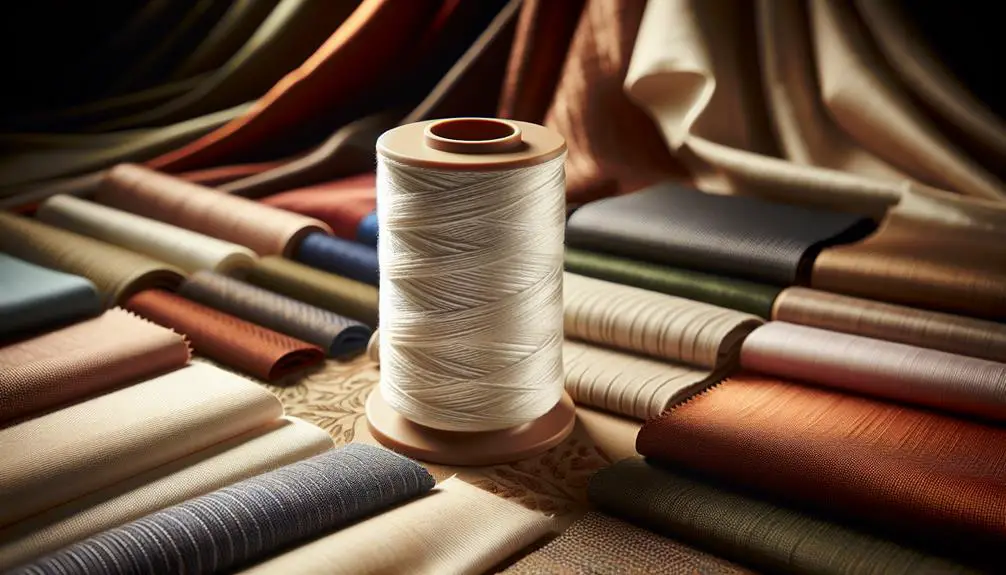I've often wondered what the true color of natural nylon is, and it turns out, it's milky white. This nearly transparent or off-white shade is not just plain but super versatile, making it perfect for a variety of uses, from everyday clothing to tough industrial parts. The shade is a sign of purity, meaning no additives are messing with its inherent qualities. Plus, this neutral color is a great start for any dyeing projects, letting colors pop spectacularly. The more you dig into how nylon's colored and used, the more you realize how its simplicity is actually its biggest strength.
Table of Contents
Key Takeaways
- Natural nylon is typically milky white in color.
- Its off-white hue signifies material purity without additives.
- The color helps in identifying products during manufacturing processes.
- This natural color serves as a versatile base for dyeing and customization.
- The milky white color enhances visibility in various application settings.
Understanding Natural Nylon
Let's dive into what natural nylon is and why its typical milky white color matters. Natural nylon, usually found in a milky white or slightly off-white shade, isn't just about aesthetics. This color, free from dyes or colorants, is key for its versatility in applications where material purity is crucial. You see, the inherent color of nylon helps in easily identifying and differentiating products during manufacturing processes.
When we talk about Nylon Type, we're referring to the specific formulation of nylon used. This varies and can slightly alter its natural color. But regardless of the type, natural nylon is celebrated for its impressive tensile strength and chemical resistance. These properties make it a go-to material in environments where both durability and resistance to chemicals are necessary.
The milky white appearance isn't just for show; it signifies that the nylon hasn't been compromised by additives. This purity is essential for applications demanding high performance without the risk of contamination from dyes. So, when you choose natural nylon, you're not just selecting a material that looks good—you're opting for a resilient, reliable product that performs consistently across various demanding settings.
Common Uses of Nylon
So, let's talk about how versatile nylon is.
You'll find it in everything from durable clothing like jackets and tights to tough industrial applications such as gears and bearings.
It's pretty amazing how this strong material pops up in both everyday items and specialized equipment.
Nylon in Clothing
Nylon's durability and flexibility make it a top choice for clothing items like hosiery and activewear. Since hitting the market, it's been a go-to for anyone needing tough, yet comfortable clothes. Its ability to resist abrasions and its strength stand ready to assist in making durable lingerie, outerwear, and more.
I've noticed how its natural off-white color meshes seamlessly with a wide variety of designs, making it not just functional but stylish too. Plus, the ease of dyeing nylon means the possibilities for colors and patterns are practically endless. Whether I'm gearing up for a workout or layering up for the outdoors, nylon's properties ensure I'm covered in both comfort and style.
Industrial Nylon Applications
While I've explored how nylon serves us in clothing, it's equally impressive in various industrial settings. The main difference lies in its applications and the specific properties it brings to each sector.
In the automotive world, nylon is key for making durable gears, bearings, and bushings, thanks to its superior strength and wear resistance.
The aerospace industry benefits hugely from its light weight and durability, using nylon in aircraft components and fasteners.
For electrical components, nylon's chemical and dimensional stability make it ideal for insulators and connectors.
Lastly, in industrial machinery, nylon's heat resistance and ease of machining enhance the efficiency and performance of tools and equipment.
Each use showcases nylon's versatility and essential role in modern industries.
Dyeing and Customization Techniques
Now that we've seen how versatile natural nylon is, let's talk about how we can play with its color.
I'll show you some cool dyeing methods, offer tips to keep those colors vibrant, and explore creative ways to customize nylon.
These techniques really open up the possibilities for both fashion and function in nylon products.
Nylon Dyeing Methods
To customize the color of nylon, various dyeing methods like solution dyeing, yarn dyeing, and piece dyeing are employed. Solution dyeing is pretty neat because you mix the color right into the nylon polymer before it's even extruded. This method locks the dye in, giving you super vibrant colors that are tough to fade.
Yarn dyeing, on the other hand, is where the nylon fibers are dyed after they're turned into yarn but before they're woven into fabric. It's great for achieving really uniform color throughout the material.
Lastly, there's piece dyeing. This one's done after the nylon fabric is already woven. It's super flexible, allowing for lots of color experimentation on the finished textile.
Color Fastness Tips
After exploring various dyeing methods, let's focus on ensuring those colors stick with some top-notch color fastness tips. Dyeing natural nylon isn't just about splashing on some color; you've got to make sure it lasts. Here are my go-to strategies:
- Pre-Wash: Always clean your nylon to remove any impurities that could mess with dye absorption.
- Temperature Control: Dye your nylon at the right heat to enhance dye uptake.
- pH Balance: Adjust the dye bath pH according to the dye specifications for better fixation.
- Dye Fixatives: Use a quality fixative post-dyeing to lock the color in.
- Proper Rinsing: Rinse thoroughly to remove any loose dye particles and prevent color bleeding.
These steps should help you master the art of nylon dyeing!
Creative Customization Ideas
Let's dive into some creative customization ideas for natural nylon, exploring dyeing and other unique techniques. Whether you're looking to personalize or brand items, there's a lot you can do!
| Technique | Description | Best For |
|---|---|---|
| Dip Dyeing | Partially immersing fabric for a gradient look | T-shirts, scarves |
| Fabric Painting | Applying paint directly to create designs | Artistic branding, prototypes |
| Using Acid Dyes | Achieves vibrant, long-lasting colors | Professional apparel |
| Using Disperse Dyes | Ideal for intricate, detailed patterns | High-fashion items |
Each method offers a way to make your natural nylon items stand out. Tailor the technique to match your vision or project requirements. Get creative and watch your designs come to life!
Properties of Unaltered Nylon
Exploring the properties of unaltered nylon, we find it's typically white or colorless and has a soft, sometimes silk-like texture. This base form of nylon is fascinating due to its intrinsic characteristics, which are vital for various applications before any modifications are made.
Here are some key properties of natural nylon to consider:
- Thermoplastic Nature: Nylon's ability to melt and be reformed is a game changer. It allows for easy molding into countless shapes, making it incredibly versatile for manufacturing.
- Soft Texture: The inherent softness of nylon makes it ideal for applications where a gentle touch is necessary, such as in textiles.
- Color: Being naturally white or colorless, nylon presents a blank canvas, which can be dyed to any color, meeting diverse design needs.
- Varieties: There are different types of nylon, like nylon-6,6 and nylon-6, each with unique properties that cater to specific needs.
- Modifiability: Even in its unaltered state, the potential to enhance nylon by adding various additives opens up a multitude of possibilities.
Understanding these properties helps us appreciate why nylon is so widely used and how it serves as a foundational material in numerous industries.
The Versatility of Natural Nylon
Natural nylon's versatility shines through its use in industries ranging from automotive to aerospace, showcasing its robust adaptability. It's fascinating how this material, often just seen as a type of plastic, plays such crucial roles. From protective gears to intricate components, natural nylon's high strength and excellent wear resistance make it a go-to material.
Now, let's talk about its other characteristics. What blows my mind is its heat resistance and dimensional stability. These features make natural nylon exceptionally reliable in environments where temperatures fluctuate wildly. It's also recyclable and has low water absorption, which adds to its sustainability—a huge win for any industry wanting to cut down on environmental impact.
Here's a simple table to help visualize some of the fantastic uses of natural nylon:
| Feature | Benefit |
|---|---|
| High strength | Supports heavy applications |
| Excellent wear resistance | Prolongs product life |
| Heat resistance | Suitable for high-temp uses |
| Low water absorption | Effective in humid conditions |
As you can see, natural nylon isn't just about being tough; it's also about being adaptable and sustainable. It's these qualities that make it such a valuable material in our modern world.
Industries Utilizing Nylon
After examining the remarkable features of natural nylon, I'll now highlight the various industries that benefit from using this adaptable material. The versatility and robust characteristics of natural nylon make it a favorite across a broad spectrum of sectors. Here's a quick rundown:
- Automotive Industry: Natural nylon is a go-to for parts that demand high strength and durability, such as under-the-hood components. Its wear resistance is a major plus.
- Electrical Components: Thanks to its chemical and dimensional stability, natural nylon is ideal for insulators, connectors, and other critical electrical parts.
- Consumer Goods: From kitchen appliances to sports equipment, natural nylon's affordability and long-lasting nature make it super popular.
- Industrial Machinery: This sector exploits natural nylon's ability to withstand high temperatures and its lightweight nature, enhancing machine efficiency.
- Aerospace Sector: Nylon's versatility and ease of machining facilitate the production of various aerospace components, proving essential for modern aviation.
These industries leverage nylon's unique properties to improve product performance and longevity, demonstrating just how indispensable this material has become in our modern world.
Environmental Impact of Nylon Production
The production of nylon has a hefty environmental cost, consuming significant energy and emitting pollutants. It's not just about the energy used; it's the whole chain reaction. The more nylon we make, the more strain we put on our planet. Factories churn out not only nylon but also a whole lot of carbon emissions and pollutants that taint our air and water.
Here's a quick breakdown in a table to show you what's happening:
| Environmental Factor | Impact of Nylon Production |
|---|---|
| Energy Consumption | High energy use leads to increased carbon footprint. |
| Pollution | Emissions contribute to air and water pollution. |
| Resource Use | Heavy use of water and energy strains resources. |
| Waste | Without recycling, nylon contributes to landfill waste. |
We've got options to mitigate these effects, though. Recycling nylon is a big one—it conserves resources and cuts down on waste. Pushing for more sustainable practices in producing nylon, like opting for recycled materials or cleaner processes, can really lessen the environmental punch. It's about making smarter choices to protect the world we all share.
Nylon Blending Additives
Let's dive into how nylon blending additives can tweak and enhance the basic properties of nylon. When I'm looking to customize nylon for specific uses, I turn to a variety of additives. Each type of additive brings its own set of benefits, and knowing just the right mix can make a real difference.
Here's a quick rundown of some common nylon blending additives:
- Glass fibers: They're fantastic for boosting nylon's strength and stiffness, making the material less prone to deformation under stress.
- Carbon fibers: Like glass fibers, carbon fibers enhance stiffness but with the added benefit of lower weight, which is crucial for high-performance applications.
- Minerals: These can be added to improve wear resistance and dimensional stability, ensuring that the nylon doesn't change shape easily with heat or mechanical stress.
- Colorants: I use these to give nylon any color I need, which is essential for consumer goods where aesthetics are key.
- UV stabilizers and flame retardants: These additives are critical for improving safety and longevity. UV stabilizers protect against sun damage, while flame retardants help prevent the material from catching fire.
Choosing the right combination of these additives allows me to tailor the nylon's properties to meet specific requirements, whether it's for automotive parts, electronics, or fashion items.
Innovations in Nylon Fabrication
In recent years, we've seen groundbreaking advancements in the fabrication of natural nylon that have expanded its application across various industries. Initially, natural nylon's white or colorless form was quite basic. Now, thanks to innovative techniques, we can manipulate this versatile material into an array of shapes and forms that suit specific needs.
The thermoplastic nature of natural nylon really shines here, because it allows for such flexibility in manufacturing processes. You can heat it, mold it, and cool it down into virtually any shape you can think of. This adaptability has opened doors in the automotive sector, electrical components, and even everyday consumer goods.
Moreover, by blending different additives with natural nylon, we can tailor its properties more precisely. Whether it's improving heat resistance, altering flexibility, or enhancing durability, these modifications make natural nylon far more useful than before. From tougher car parts that can withstand extreme temperatures to safer, more reliable electrical housings, the improvements are tangible.
Each type of nylon, be it nylon-6,6 or nylon-6, brings its own set of benefits to the table. This specificity allows industries to pick and choose exactly what they need, optimizing their products for better performance and longer life.
Future Trends in Nylon Application
Looking ahead, I'm really excited about how nylon's getting greener. There's a big push to develop eco-friendly nylon that can cut down on environmental impact.
Plus, with tech advancements, we're seeing nylon pop up in smart textiles and wearable tech, which is pretty cool for both fashion and function.
Eco-Friendly Nylon Innovations
Eco-friendly innovations are revolutionizing the way nylon is produced to meet the growing demand for sustainable materials. Here's a quick rundown of what's happening:
- Recyclable Materials: We're seeing more nylon products that can be recycled, reducing waste significantly.
- Energy Savings: Innovations aim to cut down on the energy used in nylon production.
- Sustainable Practices: There's a big push towards more sustainable manufacturing processes.
- Biodegradability: Efforts are stepping up to make nylon fully biodegradable.
- Lower Emissions: Reducing carbon footprint during production is now a key goal.
These steps are crucial as we shift towards a more environmentally conscious approach in industries relying heavily on nylon. It's all about less impact, more responsibility.
Nylon in Tech Wearables
Nylon's making big waves in the tech wearables market, thanks to its durability and lightweight nature. It's not just about what it looks like; it's how it performs. This material's really stepping up, offering that crucial combo of being tough yet comfy. Plus, it handles moisture like a champ, keeping things cool and dry.
What's really exciting is how designers are getting creative with nylon. They're pushing boundaries, turning out gear that's not only functional but also stylish and adaptable to all sorts of tech advances. And let's not forget the sustainability angle—natural nylon's recyclable, making it a win for eco-conscious consumers. I'm keeping my eye on this trend; it's going places!
Frequently Asked Questions
What Colour Is Nylon?
Nylon's color varies based on its type and use. Generally, it's dyed various shades, but if you're asking about its undyed, raw state, it usually appears off-white or has a yellowish tint.
What Is Natural Nylon?
Natural nylon's a thermoplastic, often white or colorless. It's versatile, used in various applications due to its ability to shape easily when heated and enhanced by blending with different additives.
Is Nylon Just Plastic?
Yes, nylon is essentially a type of plastic. It's made from synthetic polymers, similar to other plastics, and used in varied applications due to its flexibility and strength.
What Are the Three Types of Nylon?
I've learned that the three main types of nylon are Nylon 6, Nylon 6/6, and Nylon 6/12, each derived from different monomers and offering unique properties for various industrial applications.
- What Colour Is Natural Nylon? - April 19, 2024
- How Can You Tell if Plastic Is Nylon? - April 19, 2024
- Why Is Nylon Famous? - April 19, 2024








